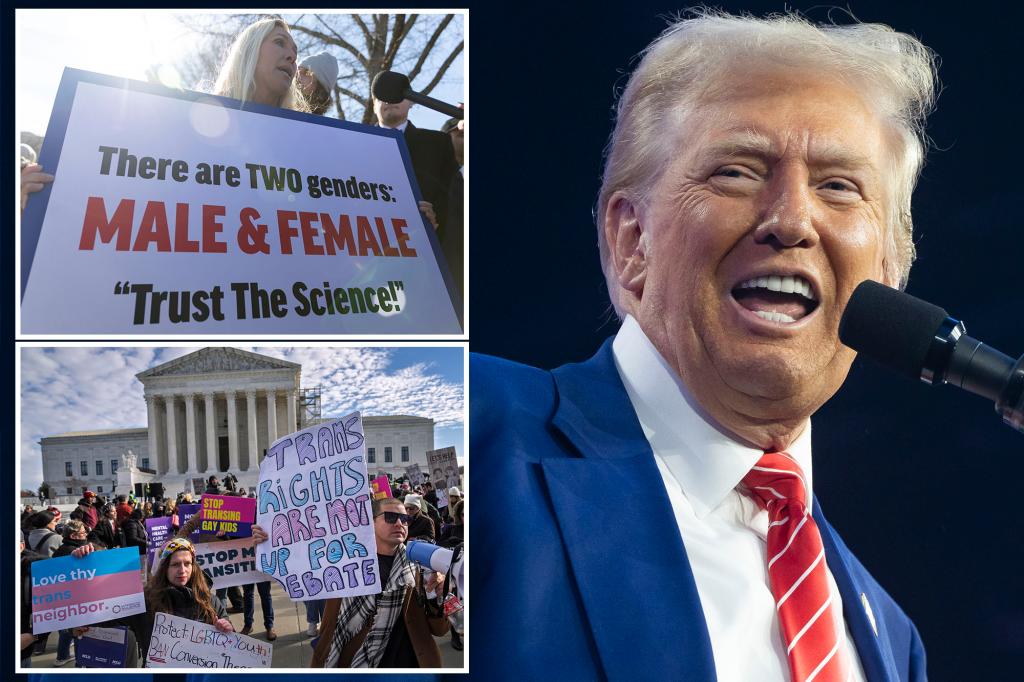Donald Trump’s declaration to halt what he terms “transgender lunacy” and officially recognize only two genders signals a potential seismic shift in US policy concerning transgender rights, should he be elected president. His statements at AmericaFest 2024, a conservative political conference, outlined a series of executive actions he intends to take on his first day in office, including ending gender-affirming care for minors, barring transgender individuals from serving in the military and working in schools, and formally establishing a binary gender definition within the US government. This hardline stance underscores a growing conservative movement against transgender rights and sets the stage for a potential legal and political battle over gender identity and expression. Trump’s rhetoric, employing loaded terms like “lunacy” and “mutilation,” further inflames an already contentious issue and echoes the escalating national debate surrounding transgender rights.
Trump’s proposed actions align with recent legislative efforts by Republicans, particularly concerning the military. His pledge to end coverage for gender-affirming care for children of military personnel echoes a provision included in the recently passed National Defense Authorization Act (NDAA). This provision, vehemently opposed by Democrats, prohibits Tricare, the military’s healthcare system, from covering gender transition-related care for minors. While the NDAA typically enjoys bipartisan support due to its crucial role in authorizing defense spending, the inclusion of this provision highlights the increasing politicization of transgender healthcare and the willingness of Republicans to leverage the NDAA to advance their social agenda. This legislative maneuver underscores the growing divide between the two parties on transgender issues and presages the likely battles to come should Trump regain the presidency.
The NDAA’s passage, despite Democratic opposition, demonstrates the growing influence of the conservative movement in shaping policy related to transgender individuals, particularly within the military. The provision targeting healthcare for children of service members represents a targeted attack on transgender rights, focusing on a vulnerable population and potentially impacting thousands of families. While the overall impact of the NDAA on defense spending and military operations remains significant, the inclusion of this contentious provision overshadows its broader implications and underscores the increasing use of legislative processes to address social and cultural issues. The debate surrounding the NDAA further exemplifies the deepening polarization within American politics and the potential for future legislative clashes on similar issues.
Trump’s proposed executive orders, coupled with the NDAA’s restrictions on healthcare coverage, signal a potential reversal of progress made in transgender rights under previous administrations. The Obama administration had taken steps to expand protections and inclusivity for transgender individuals, including allowing transgender people to serve openly in the military. Trump’s pronouncements indicate a clear intention to dismantle these policies and establish a more restrictive legal framework concerning gender identity. This potential shift in policy could have far-reaching consequences for transgender individuals, impacting their access to healthcare, employment opportunities, and overall social acceptance. The legal and social ramifications of such a policy shift are likely to be significant and could lead to further marginalization of transgender communities.
The debate surrounding transgender rights extends beyond the military and healthcare, encompassing broader societal questions about gender identity and expression. Trump’s vow to “keep men out of women’s sports” highlights the contentious issue of transgender participation in athletics, a topic that has generated heated debate and legal challenges across the country. This issue touches on complex questions of fairness, competition, and the evolving understanding of gender. Similarly, Trump’s pledge to establish a binary gender definition within the US government raises fundamental questions about the legal recognition of gender identity and the rights of non-binary individuals. These broader societal implications highlight the multifaceted nature of the debate and underscore the potential for far-reaching social and cultural changes should Trump’s proposed policies be implemented.
The battle over transgender rights is likely to continue to be a focal point of political and social discourse in the coming years. Trump’s pronouncements, the NDAA’s provisions, and the ongoing debates surrounding issues like sports participation and legal gender recognition all contribute to a complex and evolving landscape. The potential for legal challenges to Trump’s proposed executive orders and the broader implications for transgender individuals and their families are considerable. The future of transgender rights in the US hinges on the outcome of these ongoing political and legal battles, and the potential ramifications for transgender communities are significant. The evolving understanding of gender and the ongoing struggle for equality and inclusion will continue to shape this debate and determine the legal and social landscape for transgender individuals in the United States.

